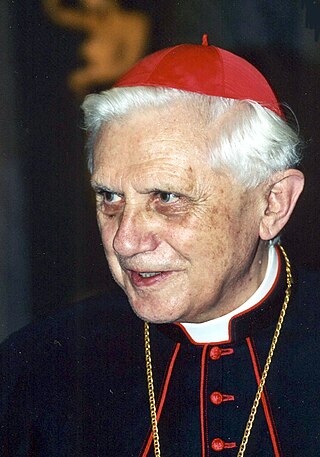Related Research Articles
Pope Gregory V, born Bruno of Carinthia, was the bishop of Rome and ruler of the Papal States from 3 May 996 to his death. A member of the Salian dynasty, he was made pope by his cousin, Emperor Otto III.

Pope Gregory XII, born Angelo Corraro, Corario, or Correr, was head of the Catholic Church from 30 November 1406 to 4 July 1415. Reigning during the Western Schism, he was opposed by the Avignon claimant Benedict XIII and the Pisan claimants Alexander V and John XXIII. Gregory XII wanted to unify the Church and voluntarily resigned in 1415 to end the schism.

Santa Maria in Palmis, also known as Chiesa del Domine Quo Vadis, is a small church southeast of Rome. It is located about some 800 m from Porta San Sebastiano, where the Via Ardeatina branches off the Appian Way, on the site where, according to the apocryphal Acts of Peter, Saint Peter met the risen Christ while Peter was fleeing persecution in Rome. According to the tradition, Peter asked him, "Lord, where are you going?". Christ answered, "I am going to Rome to be crucified again".

Pope Gregory XVI was head of the Catholic Church and ruler of the Papal States from 2 February 1831 to his death in June 1846. He had adopted the name Mauro upon entering the religious order of the Camaldolese.

Pope Pius VIII was head of the Catholic Church and ruler of the Papal States from 31 March 1829 to his death in November 1830.

Doctor of the Church, also referred to as Doctor of the Universal Church, is a title given by the Catholic Church to saints recognized as having made a significant contribution to theology or doctrine through their research, study, or writing.
John XVI was an antipope from 997 to 998.

A papal conclave is a gathering of the College of Cardinals convened to elect a bishop of Rome, also known as the pope. Catholics consider the pope to be the apostolic successor of Saint Peter and the earthly head of the Catholic Church.
A papal renunciation also called a papal abdication, occurs when the current pope of the Catholic Church voluntarily resigns his position. As a pope's time in office has conventionally lasted from his election until his death, a papal renunciation is an uncommon event. Before the 21st century, only five popes unambiguously resigned with historical certainty, all between the 10th and 15th centuries. Additionally, there are disputed claims of four popes having resigned, dating from the 3rd to the 11th centuries; a fifth disputed case may have involved an antipope.

Humanum genus is a papal encyclical promulgated on 20 April 1884 by Pope Leo XIII.

The Rhine Province, also known as Rhenish Prussia or synonymous with the Rhineland, was the westernmost province of the Kingdom of Prussia and the Free State of Prussia, within the German Reich, from 1822 to 1946. It was created from the provinces of the Lower Rhine and Jülich-Cleves-Berg. Its capital was Koblenz and in 1939 it had 8 million inhabitants. The Province of Hohenzollern was militarily associated with the Oberpräsident of the Rhine Province. Also, for a short period of time, the Province of Hohenzollern was indirectly and de facto controlled by the Rhine Province.
Quo graviora was an apostolic constitution promulgated by Pope Leo XII on 13 March 1825, in which he decreed the prohibition of membership in Masonic lodges in perpetuity.
There are many papal pronouncements against Freemasonry; the most prominent include:

Joseph Ratzinger (1927–2022) was named by Pope John Paul II on 25 November 1981 as prefect of the Congregation for the Doctrine of the Faith (CDF) formerly known as the Holy Office and, especially around the 16th century, as the Roman Inquisition.
Quo primum is the incipit of an Apostolic constitution in the form of a papal bull issued by Pope Pius V on 14 July 1570. It promulgated the Roman Missal, and made its use obligatory throughout the Latin Church of the Catholic Church, except where there existed a different Mass liturgy of the Latin Church of at least two hundred years standing.

The Diocese of Valence (–Die–Saint-Paul-Trois-Châteaux) (Latin: Dioecesis Valentinensis ; French: Diocèse de Valence is a Latin Church diocese of the Catholic Church in southern France. The contemporary diocese is co-extensive with the department of Drôme.
Auctorem fidei is a papal bull issued by Pius VI on 28 August, 1794 to condemn the tendency towards Gallicanism and Jansenist-tinged reforms of the Synod of Pistoia (1786).
Quo graviora could refer to one of two papal documents:
The Rite of Braga is a Catholic liturgical rite associated with the Archdiocese of Braga in Portugal.

The resignation of Pope Benedict XVI took effect on 28 February 2013 at 20:00 CET, following Benedict's announcement of it on 11 February. It made him the first pope to relinquish the office since Gregory XII was forced to resign in 1415 to end the Western Schism, and the first pope to voluntarily resign since Celestine V in 1294.
References
- ↑ Holy See, Breve Quo graviora (in Italian), accessed 16 November 2023